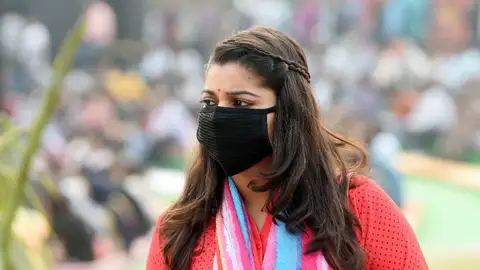 Dr. Seema Javed
Dr. Seema Javed
Delhi-NCR continues to battle air pollution for several days now. Even after slight improvement after eight days, the air quality levels are settling in the ‘very poor’ category. There are several sources that have been contributing to the rise in pollution levels, but meteorological factors play a vital role.
This year, while meteorological conditions that included good wind speed and easterly wind direction favoured the national capital earlier this season, the similar conditions are now responsible for plummeting AQI levels. Early arrival of fog over northwestern plains along with absence of winter rains over the region have been contributing factors in declining air quality over the national capital.
Experts are citing a definite role of climate change in deteriorating air quality. We have prepared a background along with experts’ quotes explaining the role of rising average temperatures in plunging air quality levels.The national capital has been witnessing a dense layer of smog since November 1, which sustained throughout the day leading to steep drop in the maximum temperatures as well as minimum temperatures.
Role of Meteorology: Early arrival of smog
While meteorological conditions that included good wind speed and easterly wind direction favoured the national capital earlier this season, the similar conditions are now responsible for plummeting AQI levels. Meteorological conditions regulate the accumulation, transport, and removal of emitted air pollutants.
In conjunction with emissions, they drive observed PM2.5 variability on hourly to interannual scales. Atmospheric stagnation, characterised by a lack of precipitation, weak surface winds, and limited vertical mixing, is particularly influential in driving the buildup of pollution near the surface. Stagnation events can, therefore, exacerbate PM2.5 pollution, even without abrupt emission increases.
Humidity over the region: Delhi usually witnesses a peak in AQI levels around Diwali, which also coincides with the peak of stubble burning in the neighbouring states of Punjab and Haryana. This season,good wind speed spared Delhi-NCR record-breaking high levels of pollution during Diwali.Thereafter, winds changed from a north-westerly direction to an easterly or southeasterly across the Indo-Gangetic Plains . However, weather conditions changed subsequently. Smog made an early appearance over the northwestern plains this year. The continuous flow of easterly winds over the plains had increased the moisture level.
This was followed by the arrival of a feeble Western Disturbance (WD) that continued to infuse humidity over the region. Post the departure of WD, clear sky and cool north-westerly winds led to a cooling of the surface and a dip in mercury. All this, when combined with moisture present in the atmosphere, led to the formation of fog over the northwestern plains of Northwest India. Winds picked up a slight pace on the evening of November 17, pushing fog across Delhi-NCR and calming down again.
“We usually witness such foggy conditions over the northern plains by the end of November or early December. During this season, initially, the easterly winds and then the passage of western disturbances (WD), although feeble, kept infusing moisture over the plains at regular intervals, paving the way for favourable conditions for the formation of smog,” said Mahesh Palawat, Vice President – Meteorology and Climate Change, Skymet Weather.
Calm winds were unable to disperse the pollutants : Fog is a condensed form of water vapour in the air, trapping the pollutants over the earth’s surface. This is then known as ‘smog’. Calm winds were unable to disperse the pollutants from the atmosphere that remained suspended in the atmosphere for a longer duration. Calm wind conditions also enhance the accumulation of water vapour in the atmosphere in a highly humid environment, which helps the fog droplets to be exposed for a more extended period in the atmosphere thereby absorbing significantly higher concentrations of air pollutants. Also, Chilly days could trap the plains in the vicious smog circle, which means consecutive days of bad air quality would persist.
Particulate Matter (PM) changes its property: Prof S N Tripathi, Dean, Kotak school of sustainability, Indian Institute of Technology-Kanpur explained that the particulate matter (PM) changes its property after coming in contact with fog, paving way for more fog. “With winters intensifying, the situation is likely to aggravate as more cold weather is associated with relatively high humidity, which increases the possibility of particulate matter (PM) holding more water. After the fog disappears, water vapour or droplets evaporate leaving the PM behind. However, a very tiny chemistry takes place here, making PM more oxidised. There is a strong relation between oxidised PM and fog condensation nuclei as compared to non-oxidized components. In fact, smaller droplets oxidise faster and oxidised PM are more efficient and thus formation of fog would be much easier than the previous day. All these conditions would result in a vicious smog circle, wherein we would not see clearance for days and that is what we witnessed in
the last few days.”
Dip in temperature and absence of winter rains
Persistent fog cover has led to a substantial dip in the maximum as well as minimum temperatures across the plains including Delhi-NCR. “Drop in mercury paves the way for stagnant conditions in the atmosphere and these cooler conditions inhibit vertical mixing within the atmosphere. With this, there are higher possibilities for air quality across the region,” said Dr V Vinoj, Assistant Professor, School of Earth Ocean and Climate
Sciences, Indian Institute of Technology Bhubaneswar. Meteorologists are expecting a further drop in the minimum temperatures in the coming days. “With cold north-westerly winds reaching the plains, minimum temperatures will drop further. With this, dispersing pollutants from the atmosphere would be very difficult. The more the minimum temperatures dip, the thicker will be the inversion layer. And the thicker the inversion layer, it would be more difficult for sun rays or winds to penetrate through this layer and disperse the pollution level,” said Palawat.
In winters, the air is thinner: During winters, the air in the planetary boundary layer (the lowest part of the atmosphere) isthinner as the cooler air near the earth’s surface is dense. The cooler air is trapped underthe warm air above, forming a kind of atmospheric ‘lid’. This phenomenon is called winter inversion. Since the vertical mixing of air happens only within this layer, the pollutantsreleased lack enough space to disperse in the atmosphere.
Absence of rains: Precipitation is also the natural way of washing out pollutants from the atmosphere.
However, rains have remained absolutely absent so far in the season. Delhi has recorded no
rainfall from October 1 to November 19. Furthermore, no respite is in offing as rains remain
far and distant.Absence of rains fails to wash-out the pollutants from the atmosphere, allowing
them to stay for a longer period and causing early smog like conditions,” added Palawat.
Climate Change to further intensify pollution levels across Indo-Gangetic Plains (IGP)
Climate change is projected to alter atmospheric circulation and precipitation patterns,
subsequently influencing the occurrence of weather patterns that worsen air quality,
especially over the Indo-Gangetic Plains.
Climate Induced changes in atmospheric stagnation: According to a recent study, ‘Impacts of current and climate induced changes in atmospheric stagnation on Indian surface PM2.5 pollution’, climate change is anticipated to alter future atmospheric stagnation patterns, impacting the effectiveness of air quality policies. The study finds that future stagnation changes result from both global CO2-driven circulation changes and local aerosol-driven meteorological responses. By 2100, the study projects an increase in winter stagnation in the Indo-Gangetic Plain (IGP) of 7 ± 3 days that leads to an increase in PM2.5 of ~7 ug/m3 in a high-warming and high-aerosol scenario. During winters, climate-induced reductions in surface wind speed are significant in the IGP,contributing to an increase in weak dispersion days—and thus more stagnation days.
 Jubilee Post News & Views
Jubilee Post News & Views






